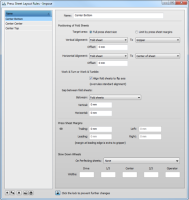Press Sheet Layout Rules
 |
A Press Sheet Layout Rule is a series of settings for positioning one or more Fold Sheets (i.e. a Fold Sheet Block) on a Press Sheet.
These rules are available in a drop-down list in the Imposition pane in the Products tab of the Job Ticket Editor. A Press Sheet Layout Rule must be selected from this list before an imposition for the Product can be created.
Apogee Impose provides ample flexibility for positioning and you can choose:
•what is to be aligned
•the horizontal and vertical reference for aligning
•and/or you can add a fixed offset
NOTE: Press Sheet Layout Rules are not applied for JDF jobs with absolute positioning.
Associated Task Processors
The Press Sheet Layout Rules resource category is available for:
•Impose
•Raster Impose
 |
Press Sheet Layout Rules Overview
Rules list
The left column of the Press Sheet Layout Rules dialog box displays a list of the default rules provided with Apogee Impose and any new rules that you may have created.
Rules are organized alphabetically and you can choose an ascending or descending order by clicking in the Name column header.
Rules settings
Name
A meaningful name, such as ‘Center Bottom’, ‘Center Center’, etc.
Positioning of Fold Sheets
Here you can choose a number of references for aligning the Fold Sheet.
Target area
The target area for positioning a Fold Sheet can be the full press sheet or the area within the press sheet margins.
Vertical/Horizontal alignment
Fold Sheet:
the entire Fold Sheet or Fold Sheet Block is aligned, including the page trim margins and overfold gap.
Page Trim
the default setting; the Fold Sheet is aligned taking into account the smallest rectangle around the final trim edges of all the pages.
Fit to sheet edges
the Fold Sheet is extended by enlarging the page trim margins and overfold lip, with priorities as set in the Fitting Strategy of the Binding Options. This option overrides all fixed positioning settings and is meant to avoid extra cuts before folding, especially for Multi-Up jobs.
Vertical alignment to
Leading Edge:
the Fold Sheet is aligned to the leading edge of the Press Sheet.
Gripper
alignment to the Gripper as set in the Press Task Processor.
Center of Sheet:
the Fold Sheet is aligned to the center of the Press Sheet.
Trailing Edge:
the Fold Sheet is aligned to the trailing edge of the Press Sheet.
Horizontal alignment to
Side Lay:
the Fold Sheet is aligned to the side lay edge of the Press Sheet.
Left Edge
alignment to the left edge of the Press Sheet.
Center of Sheet:
the Fold Sheet is aligned to the center of the Press Sheet.
Right Edge:
alignment to the right edge of the Press Sheet.
Offset
Available for horizontal and vertical positioning. The value can be:
•positive Offset: moves the Fold Sheet away from the alignment reference; when centering on the sheet: upwards and to the right.
•negative Offset: moves the Fold Sheet into the alignment reference, for example you could move the Fold Sheet into the Gripper; when centering on the sheet: downwards and to the left.
NOTE: Apogee Impose always checks that the Fold Sheet fits completely on the Press Sheet and will display an error in the Snag List if this is not the case.
Work & Turn or Work & Tumble
For Work & Turn and Work & Tumble jobs, Apogee Impose puts the front and back of a Fold Sheet on one side of a Press Sheet and mirrors this arrangement on the other side of the Press Sheet.
Work & Turn or Work & Tumble
Align fold sheets to flip axis:
overrules the standard alignment (including the offset and reference edge) and centers the Fold Sheet around the flip axis.
Gap between Fold Sheets
Horizontal/Vertical
Sets the horizontal and vertical gaps between the sides of Fold Sheets or Page trims in mm. These gaps are also applied to the distance between multiple Fold Sheets when using the Work & Turn workstyle and between elements placed on a Press Sheet for unbound jobs.
Press Sheet Margins
Margins are zones where you prefer not to have any page content, also referred to as no-content zones. If content is detected in such a zone, Apogee Impose displays a warning in the Snag List.
NOTE: Apogee Impose does not take these zone into account when calculating the imposition.
You can set the following margins along the four sides of the Press Sheet, from the sheet edge and Gripper:
Trailing
margin from page trim box to trailing edge of the Press Sheet
Leading
extra margin from page trim box to the Gripper
Left/Right
margin to left and right Press Sheet edge
Slow Down Wheels
For sheets printed on a perfecting press, you choose on of the following options to provide content-free zones for slow-down wheels:
•Automatic: The default Slow Down Wheels resource as specified for the press will be used.
•Custom: Specify the width and the number of content-free zones for this particular layout.
•None: No content-free zones will be provided for slow-down wheels.
To add/edit a Press Sheet Rule
1 Click the new button.
2 Choose the settings for this new Press Sheet Layout Rule.
3 Lock the settings.
To name/re-name a Press Sheet Rule
1 Unlock the settings and click a Press Sheet Rule.
2 Edit the name in the Name box and lock the settings again.
doc. version 13.1.1